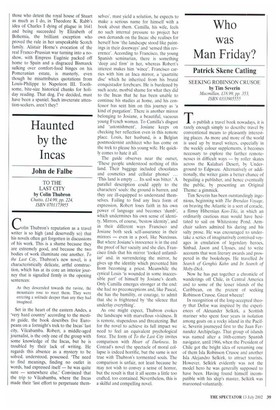Who was Man Friday?
Patrick Skene Catling
SEEKING ROBINSON CRUSOE by Tim Severin
Macmillan. 118.99, pp. 353, ISBN 0333905555
To publish a travel book nowadays, it is rarely enough simply to describe travel by conventional means to pleasantly interesting places. As more and more of the world is used up by travel writers, especially in the weekly colour supplements, it becomes necessary to explore the farther remotenesses in difficult ways — by roller skates across the Kalahari Desert, by Underground to Edgware. Alternatively or additionally, the writer gains a better chance of beguiling a publisher, and hence eventually the public, by presenting an Original Theme: a gimmick.
Tim Severin has been outstandingly ingenious, beginning with The Brendan Voyage, on braving the Atlantic in a sort of coracle, a flimsy Hibernian Kon-Tiki, in which an ordinarily cautious man would have hesitated to sail on Vv'hitestone Pond. Armchair sailors admired his daring and his salty prose. He was encouraged to undertake a series of imaginatively contrived voyages in emulation of legendary heroes, Sinbad, Jason and Ulysses, and to write accounts that won literary awards and prospered in the bookshops. He travelled In Search of Genghis Kahn and In Search of Moby-Dick.
Now he has put together a chronicle of wanderings off Chile, in Central America and to some of the lesser islands of the Caribbean, on the pretext of seeking Robinson Crusoe. Great wheeze!
In recognition of the long-accepted theorr.,, that Defoe was inspired by the experiences of Alexander Selkirk. a Scottish mariner who spent four years in isolation among goats on a rocky island in the Pacific, Severin journeyed first to the Juan Fernandez Archipelago. That group of islands was named after a 16th-century Spanish navigator. until 1966, when the President of Chile got the bright idea of renaming one of them Isla Robinson Crusoe and another Isla Alejandro Selkirk, to attract tourists. However, Selkirk evidently was not the model hero he was generally supposed to have been. Having found himself incompatible with his ship's master, Selkirk was marooned voluntarily.
My curiosity, I knew, ought to question much more than the single tale of Alexander Selkirk. There were other maroons and castaways who lived through similar adventures at much the same time ... Several had written graphic accounts of their escapades.
Severin felt that they justified a lot more travelling, a lot more travel writing.
He travelled to the isthmus of Panama and the Mosquito Coast of eastern Honduras and Nicaragua; he sailed in one of those inconvenient small craft he apparently favours, from Barbados, past Grenada and Los Testigos to Salt Tortuga, off the coast of Venezuela. His descriptions of topography and marine navigation are vividly picturesque. He decides that Crusoe's Man Friday was a Miskito Indian by the name of Will who was good at spearing fish. 'Selkirk's true character,' Severin concludes, 'was appalling.' He finds Crusoe's more likely prototype much closer to home, after gathering a great deal of historical padding. It's far-fetched; but, after all, fetching things from afar is Severin's business. There are helpful maps and some excellent, atmospheric old illustrations.
The title might well be 'Reading the Mind of Daniel Defoe', which isn't easy. Severin gives the pioneer novelist little or no credit for creating an imaginary character and presumes that The Life and Strange Surprising Adventures of Robinson Crusoe must have been modelled on reality. Writers of non-fiction sometimes seem to believe that there is no such thing as fiction. Perhaps Severin should set sail to find the island which inspired H. G. Wells to memorialise King Kong.



































































 Previous page
Previous page